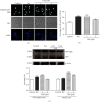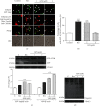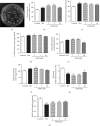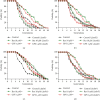Gentiopicroside, a Secoiridoid Glycoside from Gentiana rigescens Franch, Extends the Lifespan of Yeast via Inducing Mitophagy and Antioxidative Stress
- PMID: 32832008
- PMCID: PMC7421792
- DOI: 10.1155/2020/9125752
Gentiopicroside, a Secoiridoid Glycoside from Gentiana rigescens Franch, Extends the Lifespan of Yeast via Inducing Mitophagy and Antioxidative Stress
Abstract
Gentiopicroside (GPS), an antiaging secoiridoid glycoside, was isolated from Gentiana rigescens Franch, a traditional Chinese medicine. It prolonged the replicative and chronological lifespans of yeast. Autophagy, especially mitophagy, and antioxidative stress were examined to clarify the mechanism of action of this compound. The free green fluorescent protein (GFP) signal from the cleavage of GFP-Atg8 and the colocation signal of MitoTracker Red CMXRos and GFP were increased upon the treatment of GPS. The free GFP in the cytoplasm and free GFP and ubiquitin of mitochondria were significantly increased at the protein levels in the GPS-treated group. GPS increased the expression of an essential autophagy gene, ATG32 gene, but failed to extend the replicative and chronological lifespans of ATG32 yeast mutants. GPS increased the survival rate of yeast under oxidative stress condition; enhanced the activities of catalase, superoxide dismutase, and glutathione peroxidase; and decreased the levels of reactive oxygen species and malondialdehyde. The replicative lifespans of Δsod1, Δsod2, Δuth1, and Δskn7 were not affected by GPS. These results indicated that autophagy, especially mitophagy, and antioxidative stress are involved in the antiaging effect of GPS.
Copyright © 2020 Qian Liu et al.
Conflict of interest statement
The authors declare no financial or commercial conflict of interest.
Figures






Similar articles
-
Regulatory mechanisms of Gentiopicroside on human diseases: a brief review.Naunyn Schmiedebergs Arch Pharmacol. 2024 Feb;397(2):725-750. doi: 10.1007/s00210-023-02672-6. Epub 2023 Aug 26. Naunyn Schmiedebergs Arch Pharmacol. 2024. PMID: 37632552 Review.
-
Inokosterone from Gentiana rigescens Franch Extends the Longevity of Yeast and Mammalian Cells via Antioxidative Stress and Mitophagy Induction.Antioxidants (Basel). 2022 Jan 23;11(2):214. doi: 10.3390/antiox11020214. Antioxidants (Basel). 2022. PMID: 35204097 Free PMC article.
-
Isoquercitrin from Apocynum venetum L. Exerts Antiaging Effects on Yeasts via Stress Resistance Improvement and Mitophagy Induction through the Sch9/Rim15/Msn Signaling Pathway.Antioxidants (Basel). 2023 Oct 31;12(11):1939. doi: 10.3390/antiox12111939. Antioxidants (Basel). 2023. PMID: 38001792 Free PMC article.
-
Amarogentin from Gentiana rigescens Franch Exhibits Antiaging and Neuroprotective Effects through Antioxidative Stress.Oxid Med Cell Longev. 2020 Aug 1;2020:3184019. doi: 10.1155/2020/3184019. eCollection 2020. Oxid Med Cell Longev. 2020. PMID: 32831994 Free PMC article.
-
Research Progress of Natural Product Gentiopicroside - a Secoiridoid Compound.Mini Rev Med Chem. 2017;17(1):62-77. doi: 10.2174/1389557516666160624124127. Mini Rev Med Chem. 2017. PMID: 27342232 Review.
Cited by
-
Gentirigeoside B from Gentiana rigescens Franch Prolongs Yeast Lifespan via Inhibition of TORC1/Sch9/Rim15/Msn Signaling Pathway and Modification of Oxidative Stress and Autophagy.Antioxidants (Basel). 2022 Nov 30;11(12):2373. doi: 10.3390/antiox11122373. Antioxidants (Basel). 2022. PMID: 36552582 Free PMC article.
-
A New Geniposidic Acid Derivative Exerts Antiaging Effects through Antioxidative Stress and Autophagy Induction.Antioxidants (Basel). 2021 Jun 21;10(6):987. doi: 10.3390/antiox10060987. Antioxidants (Basel). 2021. PMID: 34205671 Free PMC article.
-
Regulatory mechanisms of Gentiopicroside on human diseases: a brief review.Naunyn Schmiedebergs Arch Pharmacol. 2024 Feb;397(2):725-750. doi: 10.1007/s00210-023-02672-6. Epub 2023 Aug 26. Naunyn Schmiedebergs Arch Pharmacol. 2024. PMID: 37632552 Review.
-
A Highly Efficient and User-Friendly Sensitive Skin Model on the Forearm.J Cosmet Dermatol. 2025 Jan;24(1):e16619. doi: 10.1111/jocd.16619. Epub 2024 Oct 9. J Cosmet Dermatol. 2025. PMID: 39381993 Free PMC article. Clinical Trial.
-
Gentiopicroside-Loaded Chitosan Nanoparticles Inhibit TNF-α-Induced Proliferation and Inflammatory Response in HaCaT Keratinocytes and Ameliorate Imiquimod-Induced Dermatitis Lesions in Mice.Int J Nanomedicine. 2023 Jul 10;18:3781-3800. doi: 10.2147/IJN.S406649. eCollection 2023. Int J Nanomedicine. 2023. PMID: 37457802 Free PMC article.
References
-
- Wang Y. M., Xu M., Wang D., Zhu H. T., Yang C. R., Zhang Y. J. Review on “Long-Dan”, one of the traditional Chinese medicinal herbs recorded in Chinese pharmacopoeia. Natural Products and Bioprospecting. 2012;2(1):1–10. doi: 10.1007/s13659-011-0043-3. - DOI
MeSH terms
Substances
LinkOut - more resources
Full Text Sources

